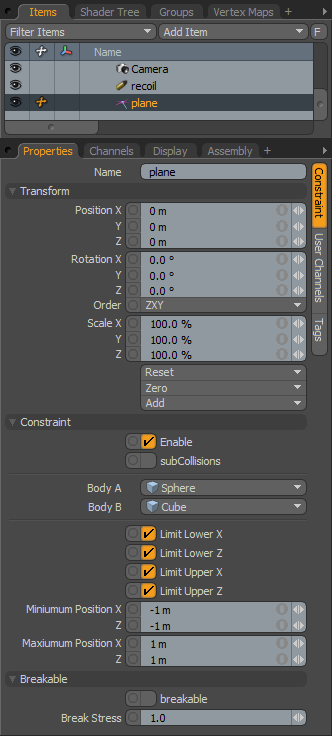
The Plane Constraint restricts the motion of an object to a flat X/Z plane (Y axis being the Up axis). This allows objects to slide over a surface. Users can control the size of the surface using the 'Limit' options and defining positions for each upper and lower side. The viewport representation for the constraint is a square denoting the edges of the plane, a diamond shape is present for each edge that is limited.
To automatically apply the Constraint, first select the item to constrain to, this will populate as the 'Body A' value when applied, and then select the constrained item, this will populate as 'Body B'. With the items selected, LMB+click on the 'Plane' constraint button, adding the constraint item to the 'Items List'. The default center location (position) of the Plane Constraint will be exactly half-way between the Body A and Body B objects with a line drawing to the center of the constrained items.
 Name: This data field displays the current Constraint item name. Users may easily change it by LMB-clicking within the field and typing the new name.
Name: This data field displays the current Constraint item name. Users may easily change it by LMB-clicking within the field and typing the new name.
Transform--
Position X/Y/Z: The Position XYZ values represents the initial center for constraint item in 3D world space, it also represents the center of mass relative to the item it is constraining. Based on its initial position, once a dynamics simulation is invoked, the constraining item will rotate and move based on this initial (resting) position.
Rotation X/Y/Z: The Rotation XYZ value represents the initial (resting) rotation of the constraining item.
Order: The 'Order' option allows the user to set the order that rotations are applied to the item, each producing a different result. Changing the order that rotations are applied can sometimes help to reduce or eliminate gimbal lock.
Scale X/Y/Z: The Scale XYZ values have no direct affect over Constraints.
Reset: Resets the selected transform values to (0,0,0) returning the item back to its default state.
Zero: Resets the chosen transform property values to '0', leaving the 'Center' position intact.
Add: The 'Add' function will add the selected set of transforms to the channel list. Useful when keyframe animating complex motions, providing a layered approach to the applied transforms. There are no benefits to applying additional transforms to dynamic objects.
Constraint--
Enable: The 'Enable' option toggles the Constraint item on or off. When enabled the constraint item will be considered during a dynamics simulation, when disabled, the constraint item will be ignored. However, disabled constraints are persistent across modo sessions being saved with the scene, and retain their present settings.
SubCollisions: The 'SubCollisions' option, when enabled, allows constrained objects (especially those within a chain, not a literal chain but subsequent groupings) to collide with one another. When disabled (the default state), fewer calculation are required, however, constrained items may inter-penetrate each other. If this occurs users will want to enable SubCollisions.
Body A: The 'Body A' setting represents the item that is constrained to, this could also be considered the parent or master item.
Body B: The 'Body B' setting represent the item that is constrained, this could be considered the child or auxiliary item.
Limit Lower X/Z: When enabled, sets a boundary limit for the -X and -Z sides of the constraining plane. Represented by an upright diamond on the planes edge. When disabled, the plane will be infinite in that direction.
Limit Upper X/Z: When enabled, sets a boundary limit for the +X and +Z sides of the constraining plane. Represented by an upright diamond on the planes edge. When disabled, the plane will be infinite in that direction.
Minimum Position X/Z: When the 'Limit Lower X/Z' options are enabled, this value is the distance away from the center position of the constraint defining its edge. The constrained item will not be able to move further than this value.
Maximum Position X/Z: When the 'Limit Upper X/Z' options are enabled, this value is the distance away from the center position of the constraint defining its edge. The constrained item will not be able to move further than this value.
Breakable--
Breakable: The 'Breakable' option allows constraints to literally be broken apart when a certain stress threshold is reached, defined by the 'Break Stress' value. When the threshold is reached, the constraint will no longer have any affect on the constrained item, leaving it to be affected by any other forces present in the simulation.
Break Stress: The 'Break Stress' value determines the threshold when the constraint will no longer affect the constrained item. The 'Breakable' option must be enabled for this value to have any affect on the constraint.


